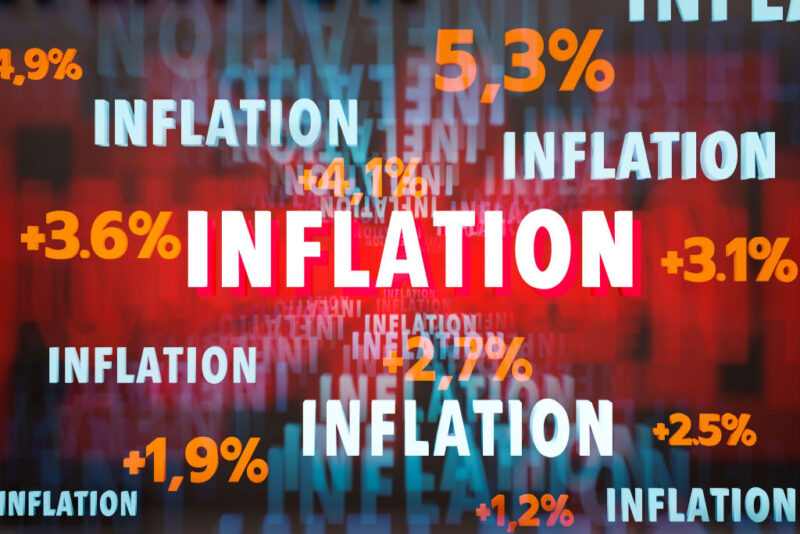Worsening stagflation means that it’s the toughest investment climate I can remember. However, that isn’t saying much given my financial market memory only goes back to the height of the Global Financial Crisis…
But the most distinguished and experienced investor I know, Charlie Morris, editor of The Fleet Street Letter Wealth Builder, just told me the same thing. It’s as tough as it gets for investors to know what to do.
What makes things so difficult is a very unusual confluence of factors.
We have high and accelerating inflation. Each new data point confounds the market anew.
But the market continues to price in plunging inflation in the future. Indeed, long-term inflation expectations have barely budged even as inflation in the near-term has taken off.
This means that financial markets are betting that the inflation we’re seeing is temporary. The protagonists think/hope that the long-term trends which kept inflation low and falling since the early 1980s will make a comeback.
Demographics are the best example for why. As population pyramids get top heavy, people will consume less. And that means falling prices.
This has always mystified me a little bit though. It only considers half the equation, after all. You can’t talk about prices without considering both demand and supply.
Yes, people consume and borrow less in retirement. But what about production?
We’ve seen the consequences of what economists call a “supply shock” play out in the news over the past year. When less stuff gets produced because of lockdowns, supply chain chaos and green energy policies, that forces up prices.
So, ask yourself what happens when people retire. Their consumption might fall a bit. But what happens to how much they produce?
Perhaps the retiring baby boomers are a supply shock of their own… The Great Resignation is. So why wouldn’t the Great Retirement be? Nothing can be more inflationary than consumption continuing while production crashes.
But… back to our list of bizarre economic trends which are making life difficult for investors.
Rising inflation while markets price in declining inflation in the future is like a rubber band that is getting tenuously stretched. What has been doing well for investors is likely to reverse.
And now, inflation is being met by a recession too.
I believe much of the world is already in a recession. But the data which determines whether we’re in a recession is backwards looking by around six months, plus the time it takes the various statistics organisations to do the maths on the aforementioned six months of data.
So, if I’m right, we have stagflation – rising prices and declining GDP.
But, again, focus on the momentum here. The rate of change is important to financial markets.
Inflation is accelerating and the economy is shrinking, if I’m right about the recession. That’s an extreme combination.
“Stagflation” can refer to inflation running ahead of economic growth. But what we seem to have right now is worse, with the economy actually shrinking while inflation accelerates.
What can you invest in, in an environment like that?
Bonds are being robbed by inflation, especially at current rates. And riskier assets are in trouble because of the recession.
Real assets, like commodities, are a popular answer. They should at least keep pace with inflation, after all. That is more than can be said for other assets in a recession.
But, ask yourself, where is all this momentum for inflation coming from?
The answer used to be obvious.
But now commodity prices are outright crashing. A whole host of commodity indices are down double-digit percentages in just a few weeks.
So, where is the inflation coming from now?
Well, producer prices are still rising. US producer price inflation measures (PPI) rose 11.3% year over year and 1.1% in June, which was much more than expected.
And, just as it takes time for higher commodity prices to flow through to producers, it takes time for producer price inflation to make it to consumer prices. That’s how Fortune & Freedom predicted our current inflationary spike just before it took off. We highlighted producer price spikes which heralded what was to come.
The big question in all this is whether you now have the buying opportunity of a lifetime in commodities as they decide to keep pace with inflation regardless of the recession. Or will they fall as demand does during the recession?
What the recession argument is missing is simple. Commodity prices are both the trigger of the inflationary pressure we’ve seen and the source of the recession too. We’re talking about resource shortages causing a recession, after all.
Energy is the most obvious example of this. Economies around the world are putting themselves on starvation diets when it comes to energy supplies, that sector is just one example.
In the Netherlands and Sri Lanka, the same ideologies are targeting farming practices. In Sri Lanka, we see the consequences. In the Netherlands, farmers are anticipating those consequences and are refusing to go along with the dogma.
In the UK and France, it was government policies on fuel that triggered protests. In Canada it was vaccine mandates for the truck distribution network.
Right across the world, with record low unemployment, the Great Resignation and the pay strikes, worker shortages have put pressure on costs for producers.
Each time, government policies imposed to reduce economic prosperity for some greater cause triggered both reduced economic activity by way of shortages and then social chaos.
My point is that commodities are at the heart of our current stagflationary mess.
So, don’t ask, “Whither commodities in stagflation?”
Ask, “Whither stagflation – do commodities go up or down?”
And I know just the person to ask…
Southbank Investment Research’s very own Commodities Queen, Shae Russell. Many of our readers have been heaping praise on Shae’s insightful guest contributions about the resource markets in recent months – with good reason! And now, in a matter of days, Shae will be hosting her own urgent broadcast event. She’s diving deep into why a “Superspike” in commodity prices could be just around the corner – and she’s got no less than FOUR ways for you to play it up her sleeve. Register here to grab yourself a spot at the event.

Nick Hubble
Editor, Fortune & Freedom



